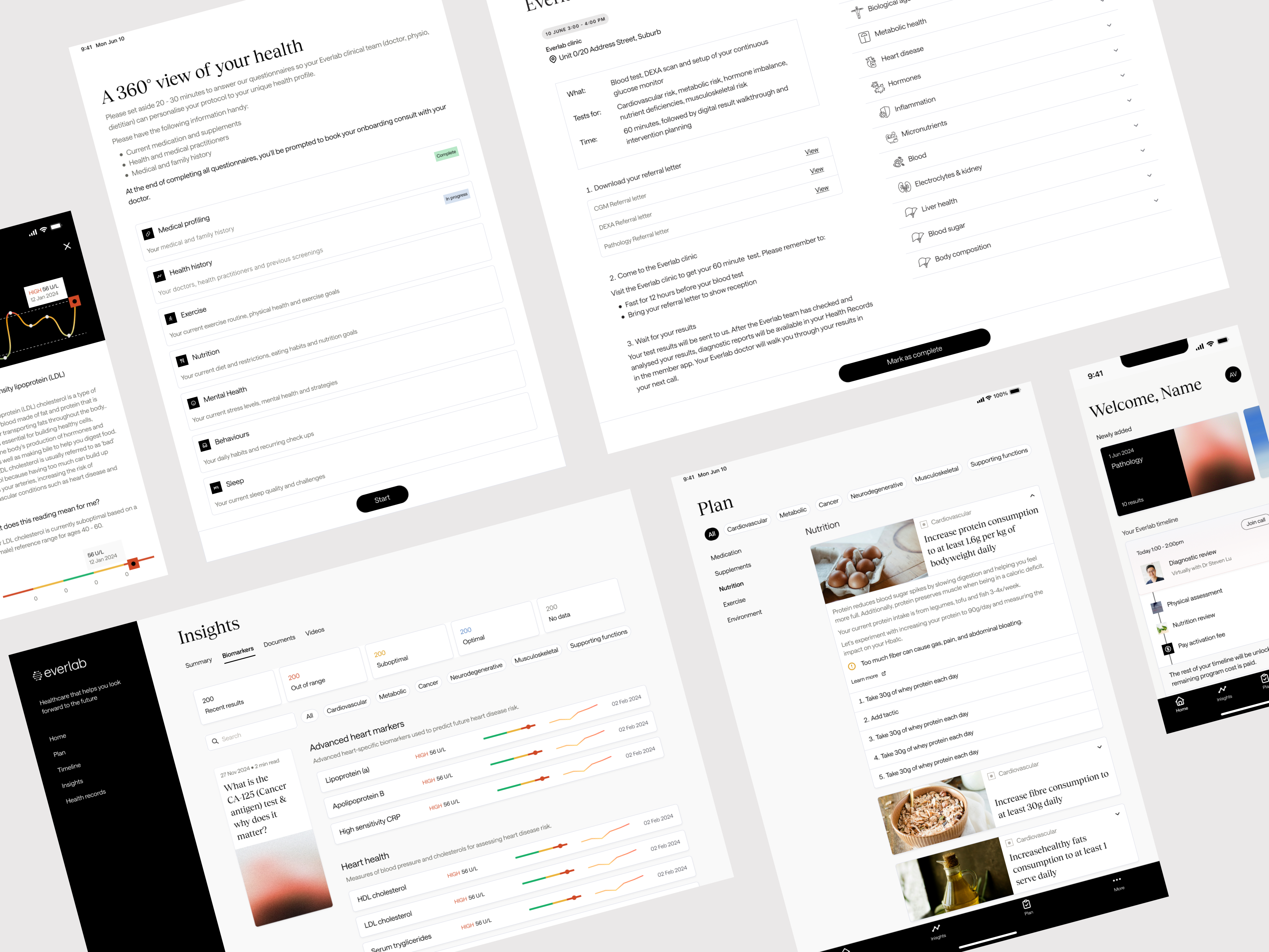Everlab
Product design | UX & UI
Everlab is a preventative health service that offers a range of screening programs to help patients detect risk of future disease and provide protocols to mitigate and reduce risk.
I joined Everlab as the founding product designer as the business prepared to scale before raising its next round of investment funding. Over the course of 5 months, I worked with the founding team to research patient and clinician needs and opportunities, build a scalable patient app and portal with a shared design system, and experimented with organic growth funnels using no-code tools.
I joined Everlab as the founding product designer as the business prepared to scale before raising its next round of investment funding. Over the course of 5 months, I worked with the founding team to research patient and clinician needs and opportunities, build a scalable patient app and portal with a shared design system, and experimented with organic growth funnels using no-code tools.
Throughout this period, I also introduced processes and frameworks to evolve our ways of working, as a distributed team needs clear alignment on priorities, open questions, decisions and release plans.
We also collaborated with the branding agency For The People in the Everlab rebrand.
We also collaborated with the branding agency For The People in the Everlab rebrand.

Researching and prioritising customer opportunities
Everlab started with one comprehensive health check program. While early adopters who went through the experience derived a lot of value from it, it also became clear that what patients wanted and needed varied greatly by demographic, socioeconomic situation and level of obsession with their health. Once an existing member has completed their first year, what interested them going forward also varied by life stage and risk levels. Everlab needed flexibility to experiment, adjust and introduce new offerings so that each patient can have the right preventative health program for them.
The medical team explored a range of potential ‘a la carte’ and ‘set menu’ health checks to address new segments and patient personas. I conducted surveys and interviews with existing and prospective patients to test these ideas along with new app features. By mapping out customer journeys and synthesising feedback, I fleshed out behavioural aspects of patients and constructed recommendations for next steps.

Building the foundations of a self-service patient app
The Everlab patient app and online portal is the patient’s digital companion throughout the Everlab programs. With an omni-channel approach, each patient can complete each task in the platform and viewport most suitable to them. Regardless of which program a patient signs up for, the same building blocks of the in-app experience scales to each stage of their journey.
When a patient first joins, they provide information about their health history and lifestyle. When they have screening or consultation appointments, they use the app to book and prepare for their sessions. And once testing results are ready or a plan has been workshopped with clinicians, the repository of the patient’s health data and Everlab’s extensive protocols are available through here as well.




Enhancing interactions with data
One of the most exciting things that Everlab patients like to talk about are their performance, and improvement to key biomarkers that are important to them. To build on this value, we continously explored ways to add context to help patients understand where they currently stand, and appreciate the progress they made by implementing their strategies.
As we explored ways to enrich the data show to each patient, we played with reference ranges, benchmarking and simulation.


Facilitating delivery planning and change management
Everlab needed modularity in both service and tech components. As a startup, many V1 functionalities were created with no-code tools, which served as a proof of concept that later needed to be replaced with more mature systems and customised functionalities.
To collaboratively ideate, validate and plan out implementation of changes, I mapped out service blueprints and logic flows to facilitate inception and validation discussions with the internal tech, clinical and operations teams.

Architecting a context and data-rich design system
We implemented Everlab’s digital product component library using the atomic design system approach, where:
- Elements are the smallest standalone ‘dumb’ UI components e.g. a button
- Molecules are more complex ‘dumb’ UI components that may contain smaller elements e.g. a card
- Organisms are ‘smart’ components that represent a backend data object, and may have more complex states depending on the context in which it appears e.g. the AppointmentCard
- Templates are dumb containers with variatons based on the context for its use e.g. a information display modal vs a form modal
- Pages are specific pages in the product, constructed using a mix of the above
For data-rich organisms, I also defined:
The tech team built the product UI components through Capacitor for them to be shareable across iOS, Android and web platforms, and between patient and clinician tools.
For the public website, a separate component library was built and managed in Webflow.
- Permission-based modes to view or edit data
- Detail-based formats such preview cards or detailed tables
- Additional states to show and hide more items
The tech team built the product UI components through Capacitor for them to be shareable across iOS, Android and web platforms, and between patient and clinician tools.
For the public website, a separate component library was built and managed in Webflow.


Company
Everlab
Everlab
Collaborators
Sarah Wise
Contractor Visual Designer
For The People
Branding agency
Sarah Wise
Contractor Visual Designer
For The People
Branding agency